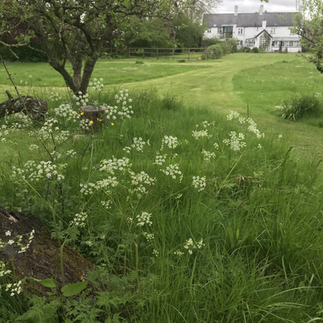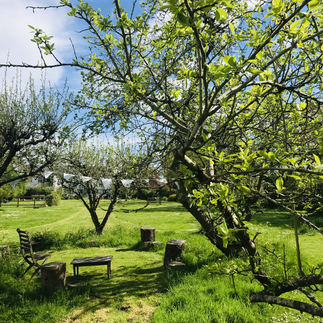7 STEPS for 'Going Wild' in the Garden
- Caroline Marson

- May 20, 2021
- 5 min read
Living in the country you get a close up view of nature in action. Seeing it so close is truly a privilege. As the bare tree glow effervescent green, blossoms bloom and the cow parsley begins to appear along the hedgerows and lanes. You know it's spring. But as I watch the beauty unfold there is always a looming worry of enviromental collapse coming our way down the road. The weather is unpredictable and unseasonal. The Jet Stream is moving slower than it has in thousands of years, a new study suggests. Human-induced climate change is largely to blame. ... And it only looks poised to worsen over the coming decades if climate change continues unabated. The beauty I’m enjoying has a sour taste. But collectively we can do something about it.

If we all did our best in our own back gardens to promote nature, what a massive global difference it could make. Because it’s often as simple as that. We have all managed to change our habits with our lockdowns. We now need to make drastic changes to how we garden.
Basically it’s time to let it go wild!!! Which is quite hard to do.. if you have a slightly OCD mind like mine that likes things tidy! But weeds are beautiful and you can eat most of them! A rambling natural garden with teeming wildlife, water ponds and native species just doing their thing, without chemical pest control, is the future. We’ve got to let our formal geometric gardens go and embrace the natural order of chaos. Nature knows, actually better than us.

7 STEPS for Going Wild in the garden
1 Stop mowing the lawn.
Leave wild spaces and paths. It looks so pretty and watch it regenerate with unexpected surprises.
2. Dump the 'Roundup' weed killer
It's killing us the bees and altering the natural flow of nature. The killer Roundup made by Monsanto has even been found in the blood stream of unborn babies.
Try these methods instead;
Hand weed the patio and beds if you really can’t cope with them!
Blanket layers of cardboard paper and newspapers. Plants will grow when they have sunshine and water...
Spray concentrated vinegar directly on weeds...
Use your trusty assistant, liquid detergent soap...
Spread some corn gluten meal around your plants...
Scald the weeds with boiling water...
Eat them. Dandelion tea or coffee... amazing! Dandelion leaves in your salad or smoothie. Nettle tops in your soup, bread. Wild garlic added to mushrooms. Cleavers, Daisies, Ground Elder, Garlic Mustard. No more weed killer!

3. Plant a tree
You've heard it from everyone.. Plant a tree! It's so impactful and simple to do. Trees breathe life into our world, and it's vital we plan for the future of woodlands to tackle climate change. Plant a tree with the National Trust Plant a tree today and you'll be helping to support the National Trust's aim of planting 20 million trees by 2030.
4. Atract Bees, Birds and Butterflys
Plant flowers with open petals which attract butterflies and bees. Bees prefer white, yellow and blue blooms. Birds like red, orange and white. Bright, vivid colors, including red, yellow and purple, draw butterflies. Butterflies and bees favor flat, open blooms with big petals for easy landings and short nectar tubes.
5 Create a Woodpile
Piles of logs loosely covered with old leaves make great homes for bugs. Standing and fallen decaying wood and old plants are very important for wildlife. Even just one or two bushes, if kept beyond their natural life, are of great value to insects, fungi, mosses and lichens.
Birds feed on insects that make their home in old wood.
In large gardens, a decaying tree with a snagged bough or a small cavity might provide a nest site for a bird or bat.
Check out the RSPB who have some great advice for creating log piles.
Dead branches also make excellent song and display perches for birds.
In large gardens, a decaying tree with a snagged bough or a small cavity might provide a nest site for a bird or bat.

6. Grow your own
Turn your garden space into a food making farm, less flowers more veg.
It forces our hands into soil, which can only mean a win/win for everyone. You become more educated and closer to nature which feels great.
There is no better achievement than growing from seed a tomato or carrot... apart from childbirth of course!
Gardening encourages a natural microbe in our guts. Which we have lost as most vegetables we eat has been cleaned.
It's good for mental health to get out in the fresh air
Kids love it and learn so much.
It's an essential life skill in my opinion. Whatever your space, you can grow food and so can your kids. I like to support these organic seed guys. https://seedcooperative.org.uk but you can buy seeds anywhere and often they cost lest than 99p.
6. Save Water.
How lucky we are to have water coming out of a tap. Might be less convenient in the future when the weather becomes more unpredictable. After a winter of being wet and flooded in my garden. I took the dried earth picture in April when we had not had rain for a month. A month later in May, all it can do is rain again! So let's get used to saving it.
Water butts can connect to guttering, save it for watering the garden when it’s dry or even using it to flush the loo. I got my water butt free from FREECYCLE
Water outdoor plants in the early morning or at the end of the day to stop water immediately evaporating in sunlight and heat.
Water the soil so that the liquid goes straight to the roots, where it’s needed.
In a heatwave, animals need water too. Instead of watering your lawn, leave out a water-filled container, like a casserole dish, for birds to drink from and wash.
Thirsty bees and other insects will need a saucer or bowl with water and stones in it.


7. Encourage birds into your garden
Put up nesting boxes and feeding stations for the little birds. For feed I like using a Robin Mix that has already been shelled, they also love peanuts and fatballs. It's so much fun noting down new birds in the garden. Check out RSPB for some great advice.
I am addicted to the app Chirpomatic which helps you identify the morning bird song. I've had blue tits, great tits, woodpecker, Goldfinch, Chaffinch, Wren, Blackbirds, Song Thrush, Wood pigeon, Corn Bunting identified with this app.
I love these copper bird feeds, they look great and slightly more interesting than the plastic varieties.
Niger seeds attract the finches
Blue Tits and Great Tits love peanuts... as do the squirrels! But make sure they are only available in feeders as any large pieces could choke little birds or baby birds.
Fat Balls are great for all the birds. If left too long in the summer months they can go rancid. So keep an eye on them.
We put up as many bird houses as we could in the early spring to encourage families of birds into our garden. We found our King Fisher Bird Boxes on Amazon paint with a wood protector paint and we fixed on protector plates to stop larger birds or squirrels the woodpeckers and magpies from taking the babies. Bird Box Plates
Meantime it's good bye from me and good bye from them....
Caroline x















































































































































































Comments